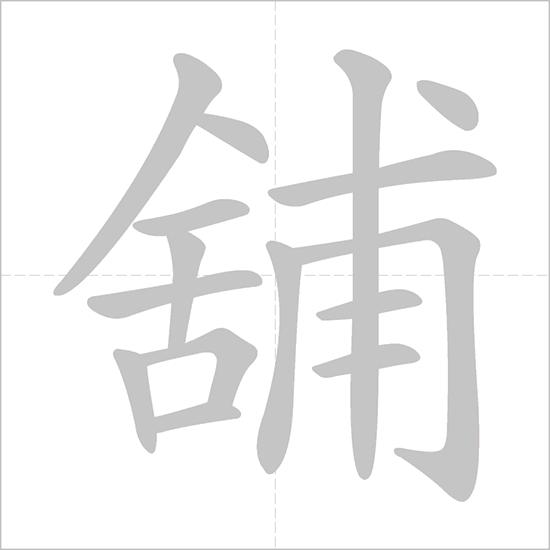Showing Results in:
- ENGLISH
- SEE TRADITIONAL
- SEE CANTONESE
-
Tone
Phonetics: Tone colors (āáǎàa):
Learn more about 舖
- Written Chinese
- Dictionary
- "舖" Character Details
Practice Your Tones!
| Pinyin | Yale | Jyutping | English Definition for Chinese Text |
|---|---|---|---|
| pou3 | pou3 | variant of 鋪|铺[pu4] / store |
How do you remember 舖 ?
Post your photos, example sentences and daily homework here to share with the Chinese learning community.
How to use 舖 in a Sentence
This passage foreshadows the climax of the story.
The little boy is learning how to sheet a bed.
The money from her dowry was invested in her mother's store.
- 火 huǒ
- 車 chē
- 突 tū
- 然 rán
- 停 tíng
- 車 chē
- , ,
- 我 wǒ
- 差 chà
- 一 yī
- 點 diǎn
- 從 cóng
- 卧 wò
- 鋪 pū
- 上 shàng
- 摔 shuāi
- 下 xià
- 來 lái
- . .
The train stopped with a violent jerk , nearly tipping me out of my bunk.
- 我 wǒ
- 重 zhòng
- 鋪 pū
- 了 le
- 卧 wò
- 室 shì
- 的 de
- 地 dì
- 毯 tǎn
- , ,
- 又 yòu
- 添 tiān
- 置 zhì
- 了 le
- 定 dìng
- 做 zuò
- 的 de
- 壁 bì
- 櫥 chú
- 。 。
I've re-carpeted our bedroom and added fitted wardrobes.
" Won't you let me get you a berth in the sleeper? "
- 我 wǒ
- 把 bǎ
- 泳 yǒng
- 衣 yī
- 和 hé
- T T
- 恤 xù
- 衫 shān
- 塞 sè
- 進 jìn
- 包 bāo
- 里 lǐ
- , ,
- 乘 chéng
- 卧 wò
- 鋪 pū
- 前 qián
- 往 wǎng
- 貝 beì
- 濟 jì
- 耶 yē
- 。 。
I crammed my bag full of swimsuits and T-shirts and caught the sleeper down to Beziers.
- 他 tā
- 從 cóng
- 由 yóu
- 倫 lún
- 敦 dūn
- 開 kāi
- 來 lái
- 的 de
- 午 wǔ
- 夜 yè
- 快 kuài
- 車 chē
- 的 de
- 頭 tóu
- 等 děng
- 卧 wò
- 鋪 pū
- 車 chē
- 廂 xiāng
- 里 lǐ
- 走 zǒu
- 出 chū
- 來 lái
- . .
He stepped out of his first - class sleeper on the night express from London.
- 這 zhè
- 些 xiē
- 練 liàn
- 習 xí
- 很 hěn
- 有 yǒu
- 趣 qù
- , ,
- 而 ér
- 且 qiě
- 為 wéi
- 該 gāi
- 課 kè
- 程 chéng
- 後 hòu
- 面 miàn
- 的 de
- 部 bù
- 分 fēn
- 做 zuò
- 了 le
- 很 hěn
- 好 hǎo
- 的 de
- 鋪 pū
- 墊 diàn
- 。 。
The exercises can be fun and a good warm-up for the latter part of the programme.
- 在 zài
- 寫 xiě
- 文 wén
- 章 zhāng
- 時 shí
- , ,
- 不 bù
- 要 yào
- 把 bǎ
- 壞 huài
- 消 xiāo
- 息 xī
- 夾 jiā
- 在 zài
- 毫 háo
- 不 bù
- 相 xiāng
- 關 guān
- 、 、
- 拐 guǎi
- 彎 wān
- 抹 mǒ
- 角 jiǎo
- 或 huò
- 過 guò
- 度 dù
- 鋪 pū
- 墊 diàn
- 的 de
- 開 kāi
- 頭 tóu
- 和 hé
- 結 jié
- 尾 wěi
- 中 zhōng
- 間 jiān
- 。 。
When you write, avoid sandwiching the bad news between an irrelevant, indirect, or overly cushioned beginning and end.
- Chinese Characters with 1 Stroke
- Chinese Characters with 2 Strokes
- Chinese Characters with 3 Strokes
- Chinese Characters with 4 Strokes
- Chinese Characters with 5 Strokes
- Chinese Characters with 6 Strokes
- Chinese Characters with 7 Strokes
- Chinese Characters with 8 Strokes
- Chinese Characters with 9 Strokes
- Chinese Characters with 10 Strokes
- Chinese Characters with 11 Strokes
- Chinese Characters with 12 Strokes
- Chinese Characters with 13 Strokes
- Chinese Characters with 14 Strokes
- Chinese Characters with 15 Strokes
- Chinese Characters with 16 Strokes
- Chinese Characters with 17 Strokes
- Chinese Characters with 18 Strokes
- Chinese Characters with 19 Strokes
- Chinese Characters with 20 Strokes
- Chinese Characters with 21 Strokes
- Chinese Characters with 22 Strokes
- Chinese Characters with 23 Strokes
- Chinese Characters with 24 Strokes
- Chinese Characters with 25 Strokes
- Chinese Characters with 26 Strokes
- Chinese Characters with 27 Strokes

